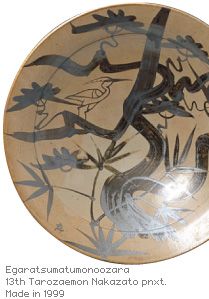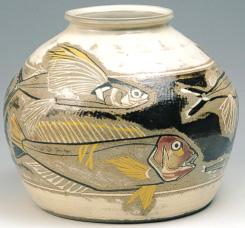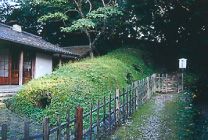

Karatsu ware appreciated by tea masters
Deeply reflects the influences of the Chinese techniques.
 Ceramics are called "setomono" in eastern Japan, while they are called "karatsumono" in western Japan because ceramic wares made throughout the Hizen district were shipped from the port of Karatsu. From the Muromachi period to the Momoyama period glazed ceramics were fired at relatively high temperatures and came to be greatly influenced by potters coerced to Japan from Korea by Hideyoshi. However, with the success in firing porcelain in Arita, Arita ware replaced Karatsu ceramics around Arita, consequently causing a decline in the Karatsu style.
Ceramics are called "setomono" in eastern Japan, while they are called "karatsumono" in western Japan because ceramic wares made throughout the Hizen district were shipped from the port of Karatsu. From the Muromachi period to the Momoyama period glazed ceramics were fired at relatively high temperatures and came to be greatly influenced by potters coerced to Japan from Korea by Hideyoshi. However, with the success in firing porcelain in Arita, Arita ware replaced Karatsu ceramics around Arita, consequently causing a decline in the Karatsu style.The revival of Karatsu ware owed a great deal to Muan Nakazato (12th Tarozaemon Nakazato), a national important intangible cultural property, who belonged to the official domain kiln and restored a number of techniques for Ko-Garatsu ware.
Different types of Karatsu ware have been appreciated by numerous tea masters. To be found among the major works of Karatsu ceramics are, Oku-Korai following the Korai tea bowls, Seto-Karatsu of honde and kawakujirade, Chosen-Karatsu coated with straw ash glaze (warabaiyu) and iron glaze (tetsuameyu), E-Garatsu depicted with iron or copper glaze and coated with translucent glaze, and Madara-Karatsu having blue spots of straw ash glaze. Karatsu ware is characterized by the paddling technique (tatakizukuri) in which strings of clay are stacked on a wheel and the outside is paddled with a wooden paddle into shape with the inside supported by battens. This is said to have been handed down from Korea.
Today there are about 60 kilns of Karatsu ware in Karatsu City, Takeo City, and Higashi-Matsura-gun. Introduced here is Tarozaemon Nakazato, a representative potter of Karatsu ware.

